A few interesting facts related to Kerala’s own ‘Pappadam’
Fried Pappadam is the special item of any Kerala Sadya. In fact a sadya is incomplete without pappadam. As per rules, Pappadam should be placed in plantain leaf before the person sits in front of it. While most of us prefer to take pappadam with Paripp and rice or other curries, a few keep it aside to serve aside sweet ada-jaggery payasam. He is the most ‘weak’ item of a sadya, but the most special person, just like a round spot (bindi) on a lady’s forehead.
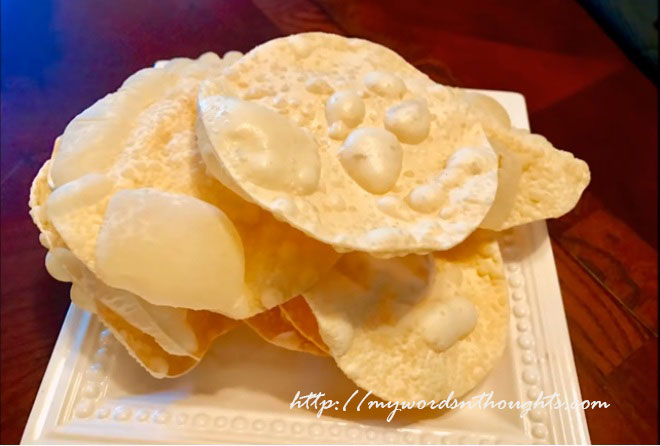
His golden colour is a charm, so is his perfect round shape with bubbles and distinct taste. A sadya without pappadam is like Onam without Mahabali. At any cost we can’t keep him away from kitchen, though Malayalis have turned health conscious now. Pappadam, banana, boli, paripp curry, kalan, pulissery, pachadi, banana chips – yellow colour owns a special space in Kerala sadya. When you prepare a special sadya at home, pappadam is the last item who gets ‘prepared’ for the ceremony, because we always fry it last. But through its pleasant aroma it tells whole neighbourhood about the special occasion, and also foretells guests to get ready to have meals.
For us he is Pappadam. When he moves across boundaries, his name and taste also changes. For Tamilians he is appalam who is a little bigger too, and for north Indians he is pappad. Kannadigans call him as Happalam. His taste varies also. He is known in different names in different places and has derivatives too. Yet one thing is common. He forms an integral part in special meals prepared for any occasion, though served at beginning or towards end. Malayalam word ‘Pappadam’ was derived from Sanskrit word, Parppadam. Through this column, let us explore some of his interesting facts, whom we call with love, ‘Pappadam’.
Pappadam frying is a wonderful piece of art
From deep frying pappadam to eating it, it’s a wonderful piece of art. You can fry it in 5 different ways. Do you know how? When it’s directly dropped in hot oil, it comes out as a newly wedded bride in a new sari happily. It has less wrinkles and bubbles. When you fully immerse pappadam in hot oil, it comes out with chubby cheeks with a lot of bubbles, as if she is in quarrel with you. If you shallow fry it, it won’t raise up uniformly. It may resemble a drunken person who has lost his direction. Sometimes it may not be well-cooked.
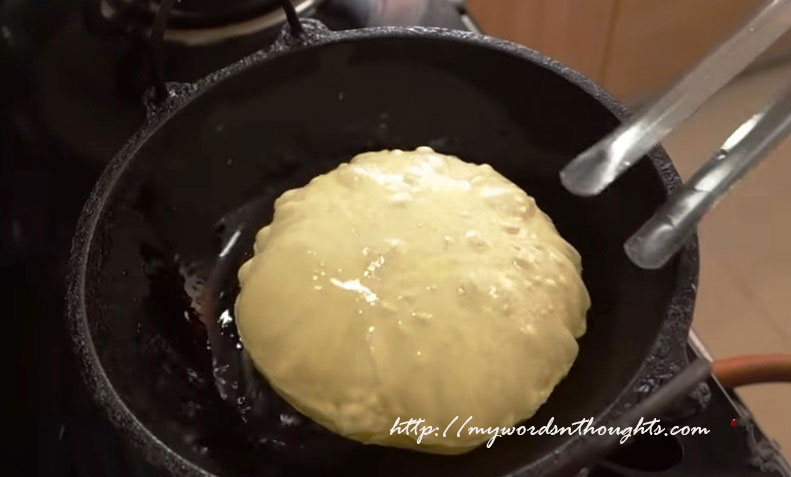
Prick the centre of pappad and dip it in hot oil. It comes out in a good shape, just like a good family man who goes to office neatly dressed and returns back punctual. Fifth method of preparation has an entirely different taste, but a healthy one, as it doesn’t need oil. Put pappadam in red charcoal or flame to cook (fire toasted). It may have dark spots here and there, and may not appear beautiful, just like a worker’s face who doesn’t get salary at month end.
You can also eat pappadam in different methods. Let me show you 5 methods. Put it directly on plate and break it in a single thrash using your hand and then have it. You can also handle him with care just like a baby, and slowly break and eat from one side. You can take him in your hand and slowly bit it and eat. You can eat him fast as if someone is watching you or slowly mix it with rice and eat. You can wait for some time till pappadam cools completely. But you won’t enjoy it eating.
How old is pappadam?
Though pappadam doesn’t have any authenticated birth certificate, history says, pappadam is more than 2500 years old. Yes, historians say, Pappadam was born 500 years before the birth of Jesus. But in those days, as coconut oil was not used, it may not be in this fried version. Several religious books of Buddhists and Jains written in 500 BC tell about pappad, their benefits and method of preparation. But there are many claims on its place of birth. Some historians argue that Bihar is pappadam’s ancestral home. Some others believe that it’s Tibet, while a few argue for Karnataka.
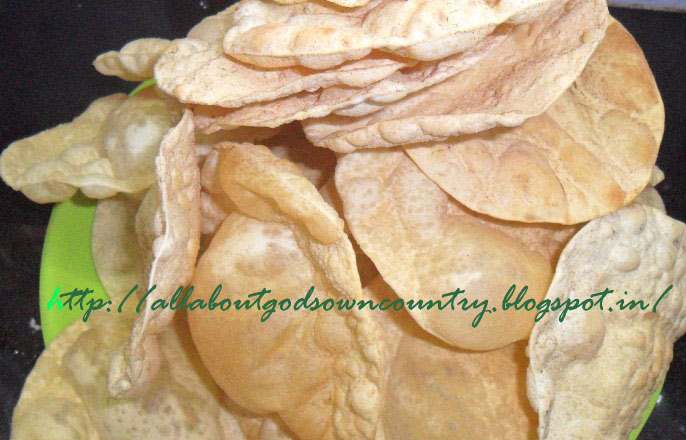
As Keralities have been open minded to different cuisines, they never claim to be the birth place of Pappads. But during old days, there was one community in Kerala who carried forward pappadam making business as their family tradition. They were traditionally called ‘Pappada Pandarangal’ in local terms. Housewives of Gaadasaaraswatha community also used to make pappadam for commercial purposes. Pappadam reached Mattancheri and Alappuzha through these people.
Pappadam is not as simple as you believe
You can see pappadam in many proverbs and folklore. It’s an integral part of Kerala cuisine too. Though tradition and time changes, Pappadam remains the same, as everyone’s favourite. In dictionary, its meaning is given as a food item that can be deep fried or cooked in red charcoal in tandoori style.
During the rule of Travancore kings, Podiyari Kanji and Chutta Pappadam (Rice Congee and Pappadam cooked in charcoal) was considered as a royal food. Pappadam is also a part of many poems and traditional folk songs. Kunjunni Mash says in his poetic style…….
“Parathi Paranjaal Parppadam….
Othukki Paranjaal Pappadam…
Vegam Paranjaal Papdam….
Chutteduthonnamarthiyaal Pdam…..”
Dated back to June 30, 1934, headlines of Malayalam newspapers read – London Mayer complimented Pappadam. An exhibition of Indian items was held in Nottingham which includd many food items and the event was organized by Indian Deputy Commissioner. The function was inaugurated by Lord Mayer. He felt that Pappadam is an excellent ‘touching’ while using liquor. It was long before different varieties of masala pappads became popular among Keralities.
Some Pappadam Memories
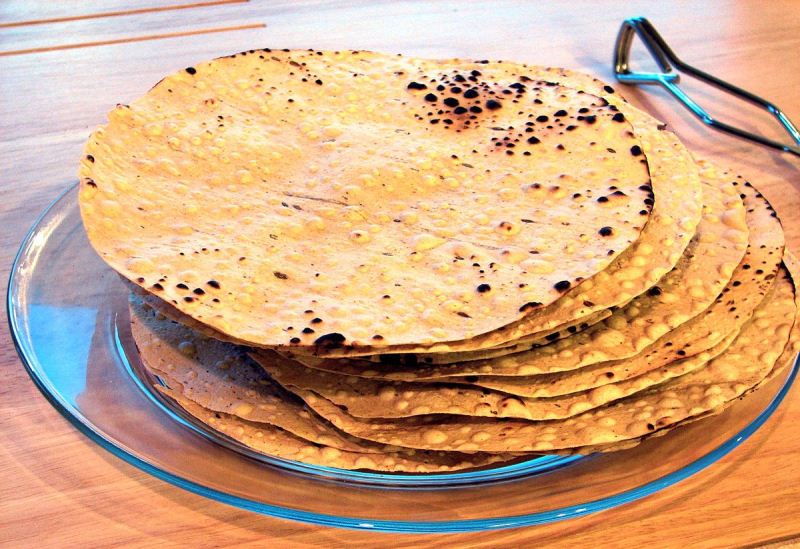
Pappadams toasted without oil
Stories of the crow trying to snatch pappadam from kid’s hand to several nostalgic Onam meals which we share with our dear ones, every one of us have some childhood memories related to Pappadam. When kids hesitate to eat meals, mothers used to say, crow will snatch your pappadam. Many bald headed people have got the pet name, pappadam. Now also there is a tradition to use raw pappadam to stick on to head for bald headed characters or fancy dress of Gandhi.
‘Njettillaa Vattayila’ is a common riddle among Malayalis and Pappadam is its answer. How beautiful and rhythmic is the word ‘pappadam’ to spell? Isn’t it? You can make any number of songs with this word. During old days, black tea or coffee along with chopped coconut pieces and fried pappads were given to guests at Kozhikode areas. ‘Chantha Pappadam’ (market pappad) was specially chosen for this purpose. Those days, pappadams were usually sold on the same day of preparation as preserving methods were not so common. So pappads bought from market had a special taste for its freshness, and were high in demand.
Pappadam has also influenced the language and usage of idioms in Malayalam. For instance, usages like ‘Njan Anganeyoru Kaachu Kaachi’ might have derived from ‘Pappadam Kaachal’– procedure of frying pappadams. In different places, this procedure is known in different names too – Pollikkal, Varakkal, Porikkal etc. Yet Kaachal is the most common word used to define ‘pappadam frying’.
There is one pappadam proverb in Malayalam – ‘Upaayam Kondu Ottayadachu Pappadam Chuttu Thinnaruth’. Pappadam was once used as an excellent gum, especially to repair pots. Raw pappadam is first soaked in water and then used to fill gaps. This proverb was derived from this particular procedure.
Pappadam making also has a rhythm
Yes, Pappadam is an integral part of Kerala Sadya. No arguments. At good old times, Sadya with 10 and 15 items in menu was not available. Sadya was not too popular also. At old times, instead of word ‘Sadya’, ‘Naalu Curry’ was widely used, which means four curries or side dishes. When meals are served in banana leaves, a big portion of the leaf will be covered by a big pappadam. As time passed by, both big and small sized pappadams occupied plantain leaves for sadyas. Now two small pappadams are most common. Instead 28 items and 6 types of desserts became a part of sadya menu. Yet if you don’t see pappadam in the leaf, it looks incomplete. Now pappadam is available in different sizes – from 25paise coin sized to elephant foot sized.
Pappadam making has a rhythm similar to Kerala’s own Chendamelam. Rolling pin used to spread pappadam looks similar to the stick used to play Chenda. Both are similar in shape. Also to spread pappadam, it has a unique rhythm and tune. The steps for rolling pappadam also look similar to playing chenda.
Earlier a roasted pappadam in charcoal, along with tender mango pickle and butter milk curry were considered great menus for lunch. Slowly we started adding pappadam with other side dishes also. Pappadam is now served with biryani, steam cake, upma etc, not just rice. Broken pappadam to these main course items adds a distinct flavour to those dishes.
Different food menus using pappadam
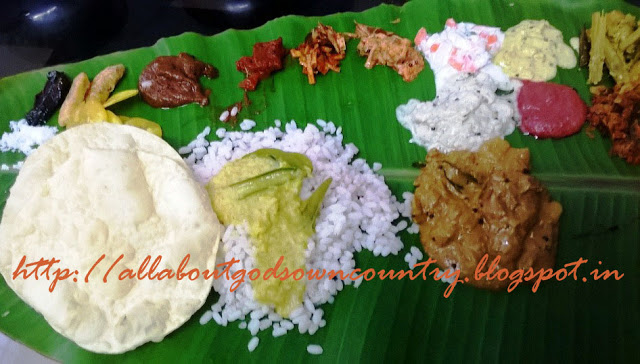
Kerala Sadya served on plantain leaf with pappadam
Earlier Pappadam had only side role in meals. But now it’s used to prepare many other dishes also. Pappadam chutney, Pappadam Thoran, Pappadam-Green gram Thoran etc are some of the common items loved by Malayalis. You can easily prepare Pappadam chutney at home, which serves best with dosa. Fry some pappadam as usual and crush it. Add a little chilli powder and salt to it and pour a little coconut oil. This chutney is also an excellent combo for rice, congee etc. Chop raw pappadam to fine pieces. Crush red chillies and a few shallots. Fry all these items adding a little oil. It’s a simple yet tasty pappadam side dish for rice.
There is one traditional Pappadam curry made in Palakkad region. Heat 1.5 spoon chilli powder and ½ spoon coriander powder and add ½ scrapped coconut. Fry the contents well. When it cools, grid it to a fine paste adding 2 or 3 shallots. Add tamarind juice and sufficient water to it and boil the contents. Cut pappadam into diamond shapes and deep fry in hot oil. Add these fried pappadam pieces to boiling curry and put off the flame. Temper oil adding mustard, fenugreek, chopped shallots and red chillies and add to Pappadam curry. During my childhood days, I have seen adding raw pappadam to Sambar for sadyas to add thickness, and I really loved to eat those ‘soaked’ pappadams when served on banana leaf.
Guruvayur Pappadam is quite famous
Guruvayur Pappadam is the leading Pappadam brand in Kerala. You can find Guruvayur Pappadam everywhere in Kerala – Kottayam, Kannur or Thiruvananthapuram, not just Thrissur. But which one is authentic? More than 1000 kilos of Pappadam are sold off in the temple premises of Guruvayur and the town every day. More than 500 families solely depend on this small scale business to earn their living. Earlier pappadam was manually made. Dough is kneaded manually, and using a particular stick (known as ‘Poovathinte Manth’ in local terms) is used to beat the dough to make it soft.
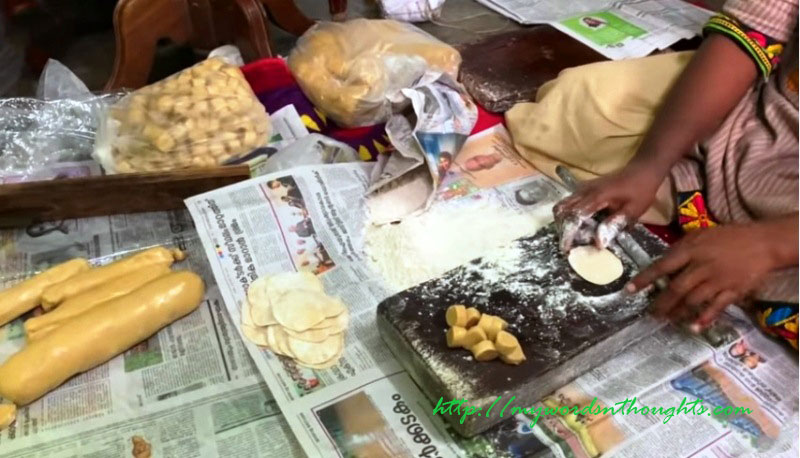
Manual method of Pappadam making
Earlier pappadam was spread using hands with the help of rolling pin and then dried under direct sun. But now everything is replaced by machines, and different sizes of pappadam are also available. They are also imported to different parts of the world. Taste and size differentiate Guruvayur pappadam from its counterparts. They are available in coin sizes as well as ‘moon’ sized. Now red chillies and crushed black pepper are also added to bring different flavours to normal pappadam. Small sized masala pappadam is also high in demand.
Derivatives in pappadam taste
A fried pappadam, a little coconut chutney and a pickle or a little curd – a Malayali at any corner of the world still love to have rice for lunch with this simple menu. Interestingly some people of older generations also loved to pour a little leftover coconut oil (after frying pappadam) to rice and sprinkle some salt to serve rice.
Onavattan and Onam
There were many Onam and Vishu leisure games in the glorious yesterdays, where pappadam played an important role. Do you know what Onavattan is? It’s a special type of big pappadam specially prepared during Onam season. A few Onam sports were also once associated with Onavattan. One common sport was ‘Pada Pappada Kali’. Pappadams are fried and hung in playgrounds. These big pappadams should not be broken anywhere. Blindfolded contestants should either bite or break pappadam with a stick to win the game. During those old glorious days, ‘Pada Pappada Kali’ was quite common everywhere.
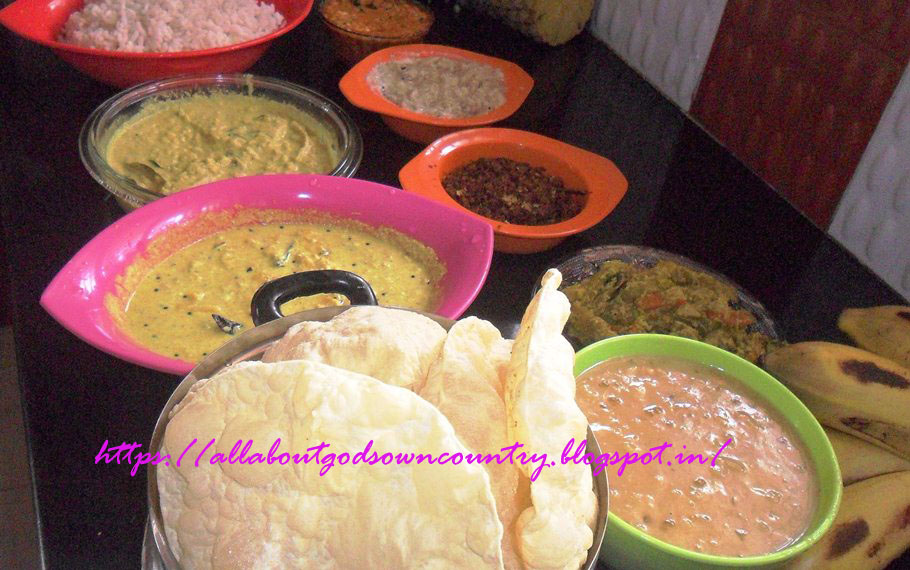
In a derivative of above fun, fried pappadams are hung at heights and the contestants should swing and reach there to bite those pappadams. In short, the contestant who flies maximum height in the swing and reaches pappadam win the contest. During death ceremonies too (like adiyantharam), people used to hang big sized pappadam, as an offering to ancestors/Karanavar and make them happy.
Now Pappadam is not free of fashion trends
In certain places of Kozhikode, pappadams served for marriage sadyas will have the name of bride and bridegroom imprinted. Interesting? In a party conference held at Kannur, a red coloured icon of star and sickle was also imprinted, surprising everyone.
Kerala Pappadam is mostly prepared using black gram. Rice powder and tapioca powder may also be added while preparing pappadam and appalam. Many other combinations are also experienced these days. Yet normal pappadam prepared using urud dal (black gram) is most favourite. North Indians love pappads with cumin seeds and they are a bit more spicy and salty too. They also love big sized corn pappad with crushed black pepper. For North Indian meals they are not fried in hot oil. Instead they are fried oil-free (fire toasted) and folded to resemble half-moon and served along with ‘thali’. In Rajasthan, pappads are served last for meals, and sweets are used as starters. The host may ask if they can bring pappad, indicating that menu items of meals have ended.
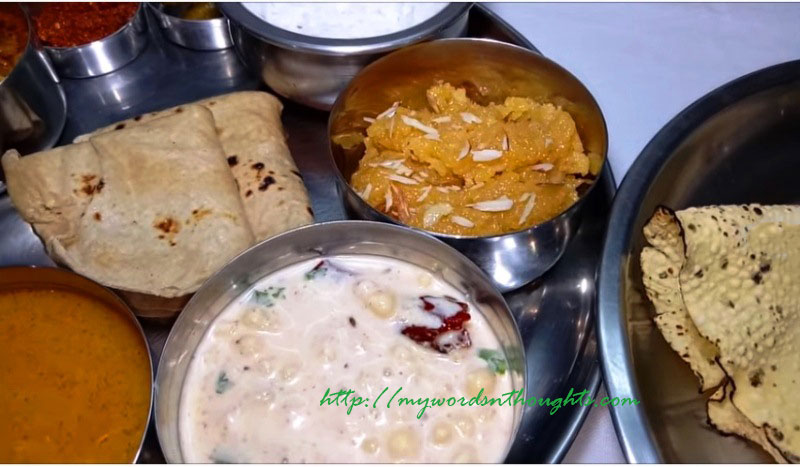
North Indian Thali with fire toasted pappad
In Uttar Pradesh, pappads are made using sago, and they are available in multi-colours. Tamil Brahmins also use sago pappadam for evening tea, which increases its shape manifold while frying. Such pappads are available in Kerala markets too. Now pappadam is dipped in rice batter, Bengal gram batter etc with added spices to get different varieties.
Stories of pappadams never end here…….
Also read a few more pappadam recipes here:

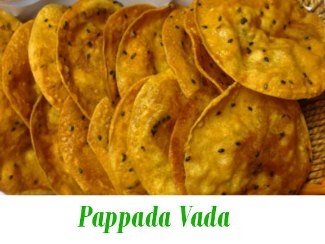
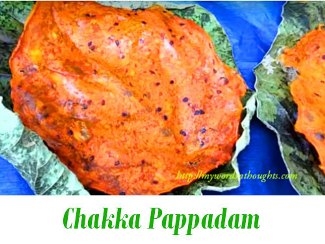
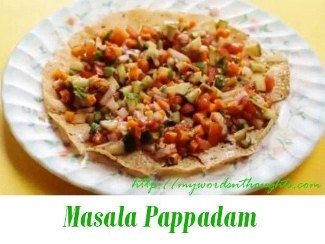
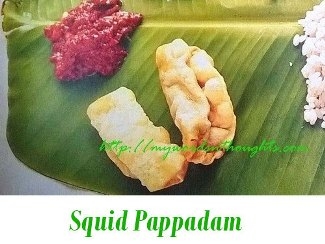
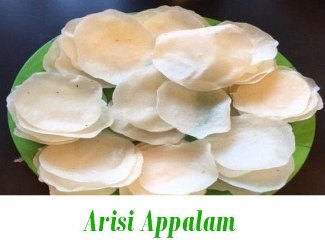








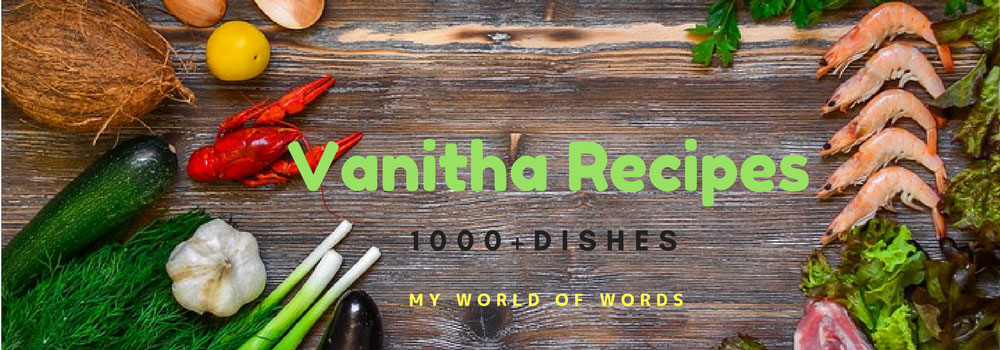
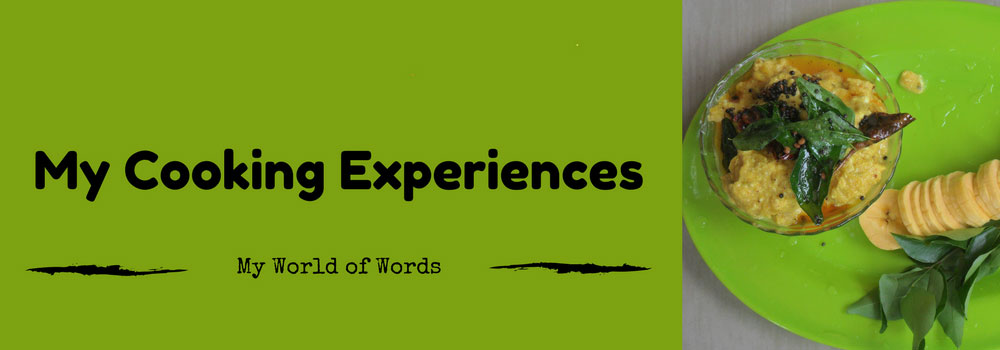


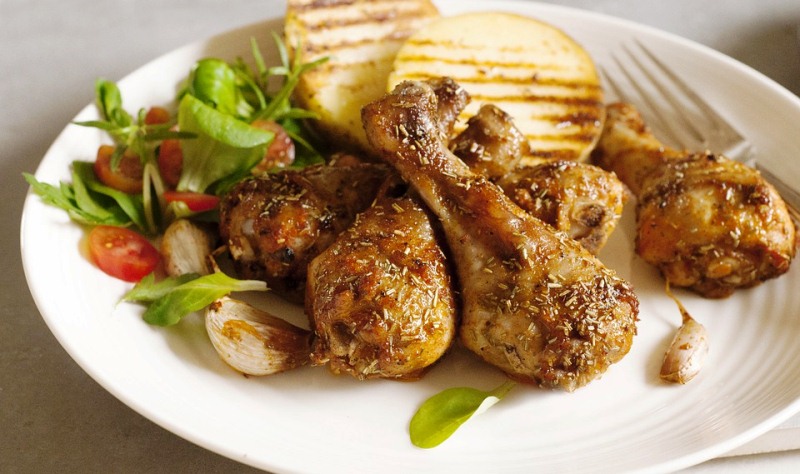
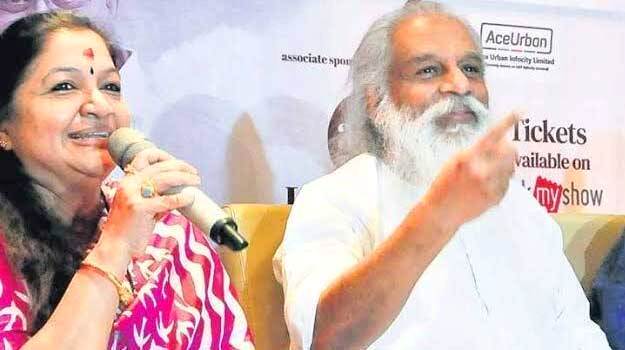
Really enjoyed your writing about pappadam keep writing
Thank you